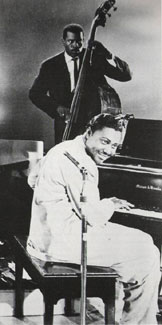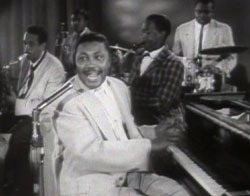 The R & B roots-rock number Rocky Mountain (1954) is performed by Amos Milburn backed up by the Paul Williams orchestra, in this Studio Films telescription that was sewn into the half-hour compilation Showtime at the Apollo: Downbeat Revue (1955).
The R & B roots-rock number Rocky Mountain (1954) is performed by Amos Milburn backed up by the Paul Williams orchestra, in this Studio Films telescription that was sewn into the half-hour compilation Showtime at the Apollo: Downbeat Revue (1955).
From 1950 to 1953, three-minute films were made specifically to be shown on television much as three-minute records were aired on radio. They were initially made by Snader Telescriptions in Los Angeles, then by Studio Films on Manhattan.
In 1953 & 1954, Studio Films following the same format made a great many more telescriptions but with a slightly different plan in mind. The earlier Snader telescriptions would be combined in rather random orders together with new telescriptions from Studio, in half-hour programs for television, & feature-length selections for theatrical releases in 1955.
With clever editing-in of "curtains" & the presence of an emcee & his comedian friends, an impression was given that each selection was an evening of live entertainment at the Apollo Theater, rather than collections of films separately made through a four year period.
Showtime at the Apollo: Downbeat Revue includes recycled Snader telescriptions by Nat King Cole (I Love You for Sentimental Reasons 1951) & Count Basie (I Cried for You, 1950), plus new Studio telescriptions by The Clovers (Little Momma, 1954), & Dinah Washington (My Lean Baby, 1954). Willie Bryant's emcee duties are spliced in along with comics Freddy & Flo, & tapdancers The Three Businessmen of Rhythm.
For Rocky Mountain, Amos sits at his piano, a big good looking man, turning his head repeatedly into a microphone to face the camera, singing:
"I'm gonna tell my baby if she wants to find me/ I'm up on a mountain as high as I can be/ Rocky mountain. Rocky mountain. Rocky Mountain, that's where I long to be./ Now I can't save a nickel, I can't save a dime/ This husslin' & stufflin', I leave it all behind/ Rocky Mountain. Rocky Mountain. Rocky Mountain, that's where I long to be."
At this time in history boogie riffs on pianos were still generally of a specific type, but Amos takes the piano solo into original directions. His smooth sometimes smoky voice is tremendously cool & sweet to hear. His influence on Fats Domino & Chubby Checkers is obvious in this number.
The record for "Rocky Mountain" had only recently been released, in February of 1954, with a very different take than on the live-recorded telescription.
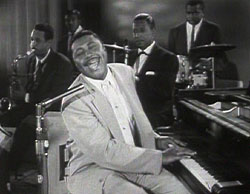 All of Amos Milburn's Studio Films telescriptions were filmed in one day then stockpiled with older telescriptions.
All of Amos Milburn's Studio Films telescriptions were filmed in one day then stockpiled with older telescriptions.
Bewildered (1954) first aired within the television segment or selection of telescriptions Showtime at the Apollo: Basin Street Revue (1955) together with older Snader telescriptions by Cab Calloway (Calloway Boogie, 1950), Sarah Vaughan (These Things I Offer You 1952) & Herb Jeffries (A Woman is a Worrisome Thing, 1950), & new Studio telescriptions by Faye Adams (Somebody, Somewhere, 1954), Ruth Brown (Hey Momma He Treats Your Daughter Mean, (1954) & The Clovers (Lovey Dovey, 1954). Also spliced in is some comedy & dance by Coles & Atkins.
This is a sweet, thrilling, romantic ballad verging into torch-song, which Amos interprets so, so beautifully in a silken whispery manner, reminiscent of Nat King Cole. The lyrics run:
"Bewildered. Lost in a dream of you/ Where is the love I need/ Why did we part/ Bewildered. Helpless without you dear/ Wishing your heart would feel/ What's in my heart."
"Must I have sleepless nights & endless days/ Oh love, why did you keep my soul/ WIthout a spark, now I'm left in the dark."
"And I'm bewildered/ I need your guiding hand/ I'll never understand/ How you can love me & leave me bewildered."
He looks so good with his handsome round face, white suit, beautiful hands on the Mason & Hamlin keyboard. He makes a tremendously cool impression, a joy to see & hear. His smooth vocalization is matched by the dreamy beauty of his piano solo.
This number reached the R & B charts for Amos in 1948, his second hit that year, following "Chicken Shack Boogie," & a wonderful break from his usual hard rhythms. The Studio telescription with Paul Williams' band is very different from the record release.
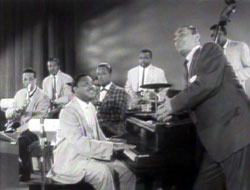 Amos Milburn his first records in 1946 with Aladdin Records in Los Angeles, starting with the number he later did as the Studio Telescription, Down the Road a Piece (1954).
Amos Milburn his first records in 1946 with Aladdin Records in Los Angeles, starting with the number he later did as the Studio Telescription, Down the Road a Piece (1954).
This three-minute film was sewn together into a half-hour television episode Showtime at the Apollo: Blues in Harlem (1955), together with new Studio telescriptions by Dinah Washington, The Clovers, & Larry Darnell, & older Snader telescriptions, two by Duke Ellington & one by Herb Jeffries. This hodgepodge was made to seem "of a whole" pretending to have occurred at the Apollo Theater by adding Apollo emcee Willie Bryant & comic Nipsey Russell.
Often Bryant was pretending to be talking to or about the next performer by standing on the sidelines, or in front of a curtain that became a "screen wipe" to disguise the cut to film footage Bryant was not really connected with.
But for Down the Road a Piece, Willie & Amos really were on the Studio Films soundstage together, so that Willie could on this unusual occasion lean on the piano & mug for his own attention.
Willie asks, "Say Amos. Where was you going the other night when I saw you walking down the street?" Amos replies, "Oh, I wasn't going anywhere Willie, I'd been where I was going." Willie: "You know, I sure would like to latch on to some of that fine boogie woogie piano playing tonight." "You mean some of that fast boogie?" "That's what I mean." "Well that's what I'll be." "Yeah!"
Amos has been banging on the piano this whole while. After the chitter-chatter with Willie, he goes into a thrilling boogie woogie performance, on a number that would be passed on to the rock world in years to come, & in which some little bit of Chuck Berry can already be heard even before Chuck covered the song himself:
"Now if you wanna hear some boogie like I'm gonna play/ It's just an old piano & a knock-out bass.../ Man it's better than chicken fried in bacon grease/ Come on along with me boys, it's down the road apiece..."
The boogie instrumental breaks are top-notch, with Willie standing by the piano the whole time snapping his fingers & shaking his leg.
For a while Amos had his own back-up band, the Chickenshakers, named after his signature song "Chicken Shack Boogie."
But for the telescriptions he worked with the highly skilled Paul Williams Orchestra which was the house band for a great many of the Studio telescriptions filmed in 1954. Any similar short-short film that has Paul Williams' band in it will always be one of the last cluster of telescriptions made. Happily Paul had a great combo & does the various performers every justice, including the great Amos Milburn.
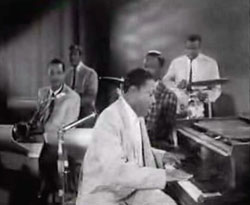 Chicken Shack Boogie (1954) was Amos Milburn's signature song, one of several R & B chart hits he had in 1949.
Chicken Shack Boogie (1954) was Amos Milburn's signature song, one of several R & B chart hits he had in 1949.
Call it jump-jazz, Rhythm & Blues, boogie, or roots-rock, what it is for sure is a great number. For a while Amos had his own combo called the Chickenshackers named after this song, & it also lent its name to the British blues band Chicken Shack in the late '60s.
The idea of a fried chicken joint as the hippest place in town began with Tillie's Chicken Shack in Harlem, so that all across America wherever there were jazz clubs there was apt to be a "chicken shack" not many actually serving chicken, but whether or not you could also eat in the joint, the very name implied the hippest sort of jazz. (See also Mabel Lee's jukebox soundie Chicken Shack Shuffle, 1943).
Milburn's sound came from out of the hipster club scene of Houston, Texas. A couple years before he made these telescriptions, he was most associated with clubs in & around Watts in Los Angeles, when there were still jobs in Watts & it was an African American cultural center especially around Central Avenue.
He was a touring powerhouse through the mid-fifties but inexplicably his career had already faded by the end of the '50s, perhaps because he was too associated with "drinking songs" like "Bad, Bad Whiskey," "Thinkin' & Drinkin'" & "Let Me Go Home, Whiskey." These meant he was regarded as an inappropriate entertainer for 'teens, & '60s radio play, which defined what could be hits, was aimed increasingly at an underage audience. He cut a final, & great album in 1962, but it did not sell, & is now only a collector's rarity.
In the telescription Chicken Shack Boogie Amos is playing a driving beat, as he begins to rap-sing lyrics quite different from his 1948 version:
"Hello cats, I just got back/ I'm lookin' for a place they call the Chicken Shack/ Say it's fine as wine & it's really on a ball/ No windows, no doors, it's just a hole in the wall."
He boogies it up on that piano between quatrains, while two saxophones from the Paul Williams band help keep the beat strong. Camera work is simple but varied enough from close-ups of Amos's good-lookin' face which the camera so loves, then close-ups of his good-lookin' hands, & shots from further back so the Paul Williams combo is also visible, varying from telescoping images, jump-cuts, & pans. For a Studio telescription, this is doing a lot, as often the camera was nearly stationary for these little films.
This telescription was included in the television episode Showtime at the Apollo: Beale Street Revue (1955), together with Cab Calloway Snader telescriptions One For My Baby, One More for the Road (1951) & Saint James Infirmery (1950), Martha Davis's Martha's Boogie (1951), Herb Jeffries' My Basin Street Blues (1950), & Sarah Vaughan's You're Mine in Every Way (1951), plus a Studio telescription of The Larks singing Margie (1954), splicing in a bit of comedy from Nipsey Russell & emceed by Willie Bryant pretending this is all occuring on one night.
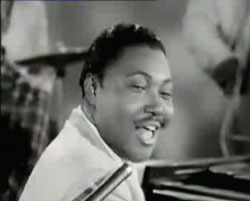 I'm Gonna Tell My Mama (1954) was included in the television episode Showtime at the Apollo: Jazz Time (1955) together with older Snader telescriptions of Lionel Hampton performing Air Mail Special & Slide, Hemp, Slide (1951), the Delta Rhythm Boys singing Dem Bones (1951), & Cab Calloway singing I Can't Give You Anything but Love (1951), plus a second Studio telescription of Ruth Brown singing Goodbye, Have a Good Time (1954), & the dated comedy of Nipsey Russell & Mantan Morland.
I'm Gonna Tell My Mama (1954) was included in the television episode Showtime at the Apollo: Jazz Time (1955) together with older Snader telescriptions of Lionel Hampton performing Air Mail Special & Slide, Hemp, Slide (1951), the Delta Rhythm Boys singing Dem Bones (1951), & Cab Calloway singing I Can't Give You Anything but Love (1951), plus a second Studio telescription of Ruth Brown singing Goodbye, Have a Good Time (1954), & the dated comedy of Nipsey Russell & Mantan Morland.
On Amos's 1951 record for this song (on the flipside of the hit single "Bad Bad Whiskey"), the sax solo is much larger. Although the Paul Williams band could easily have duplicated that sax sound, we get only a subdued pair of saxophones while Amos stays in maximum control in the 1954 telescription.
It's a tattle-tale piece of boogyin' jump-blues: "I'm gonna tell my mama what you've been doing to me/ I'm gonna tell my mama what you've been doing to me/ I'm gonna tell her that you kisses taste like wine/ Send cold chills up & down my spine/ I'm gonna tell my mama what you've been doing to me."
There's more boogie piano than lyrics, & what song this is to dance to. Whether the lyrics really mean he's going to go tell his mom he's been getting it on with some sweet thang, or if by his mama he means he'll tell his current girlfriend he's cheating, it's hard to know which, for neither one would be quite the person to go bragging to.
See also the review of Rhythm & Blues Review (1955) for a review of Amos's classic Bad Bad Whiskey (1954).
copyright © by Paghat the Ratgirl
|
